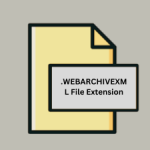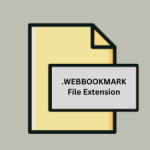.BML File Extension

What is an BML file?
The .BML file extension is associated with a specific type of data file. These files are often used for a variety of purposes, including but not limited to storing information in a structured format that can be easily read and written by software programs.
More Information.
.BML files were initially created to serve a specific purpose, such as storing configuration data, user information, or other structured data types.
The history of this file format is closely linked to the evolution of the software or system it was designed for, reflecting changes in technology and user requirements over time.
Origin Of This File.
The origin of .BML files is tied to the software or system that first implemented this format. This file format was developed to meet specific data storage or transmission needs, and its adoption varies based on the industry or software ecosystem.
File Structure Technical Specification.
The structure of a .BML file typically follows a specific schema or format, which includes headers, metadata, and data segments.
This structure is designed to optimize data storage, retrieval, and processing. The technical specifications detail how data is encoded and organized within the file.
How to Convert the File?
Converting a file to a different format can be a straightforward process, but it depends on the specific type of file you’re working with and the desired output format.
Below are general guidelines for converting files on different operating systems:
Windows
- Find a Conversion Tool: Use a file conversion software compatible with Windows. Many free and paid applications are available that can convert a wide range of file types.
- Install the Software: Download and install the chosen conversion tool.
- Open the Software and Load the File: Launch the software and use its interface to open the file you wish to convert.
- Select the Output Format: Choose the format you want to convert the file to.
- Convert and Save: Execute the conversion process and save the new file in the desired location on your computer.
Linux
- Choose a Conversion Program: Select a program that is capable of converting your specific file type. This could be a command-line tool or a graphical application.
- Install the Program: Use your Linux distribution’s package manager to install the software.
- Use the Program to Convert the File: Follow the program’s instructions to load, convert, and save your file in the new format. For command-line tools, this will involve typing the appropriate commands in the terminal.
Mac
- Identify Appropriate Software: Find a Mac-compatible file conversion application. The Mac App Store or online software repositories are good places to look.
- Install the Application: Download and install the software on your Mac.
- Open the File in the Application: Run the application and load the file you want to convert.
- Choose the Desired Format and Convert: Select the output format and initiate the conversion process. Once complete, save the new file.
Android
- Find a Suitable App: Look for a file conversion app in the Google Play Store that supports your file type.
- Download and Install the App: Install the chosen app on your Android device.
- Open the App and Load the File: Launch the app and open the file you wish to convert.
- Select the Output Format and Convert: Choose the format you need and start the conversion process. Save the converted file in your device storage.
iOS
- Search for a Conversion App: Use the Apple App Store to find an app that can convert your file type.
- Install the App: Download and install the app on your iOS device.
- Load the File in the App: Open the app and import the file you want to convert.
- Choose Output Format and Convert: Select the new format and convert the file. Save the converted file to your device or cloud storage.
Advantages And Disadvantages.
Advantages:
- Structured Data Storage:
.BMLfiles provide a systematic way to store data, making it easier to manage and retrieve. - Compatibility: Often designed to be compatible with specific software, ensuring smooth data processing and integration.
Disadvantages:
- Limited Accessibility: These files may require specific software to read or edit, limiting accessibility.
- Format Dependency: Data stored in
.BMLfiles might be dependent on the file format, making it challenging to migrate to a different format.
How to Open BML?
Open In Windows
- Find a Compatible Application: First, you need to have a program that can open BML files. This could be a browser, a special viewer, or a development tool that recognizes the BML format.
- Install the Program: Once you have found the appropriate application, download and install it.
- Open the File: Right-click on the BML file, select “Open with” and choose the installed program. If the program supports the format, the file should open.
Open In Linux
- Identify Suitable Software: Linux may require specific software for opening BML files, such as a web browser or a specialized viewer.
- Install the Software: Use your package manager (like apt, yum, or pacman) to install the identified software.
- Use Terminal or File Manager: You can open the file through the terminal by typing the application name followed by the file path, or right-click on the file in your file manager and select the installed application.
Open In MAC
- Locate a Compatible Program: Mac users can use web browsers or specialized applications to open BML files.
- Download and Install the Program: After finding the right application, download and install it on your Mac.
- Open the File: Right-click the BML file, select “Open With,” and choose your installed application.
Open In Android
- Find an App: Look for an app in the Google Play Store that can handle BML files. This might be a file viewer or a browser.
- Install the App: Download and install the chosen app.
- Access the File: Use the app to navigate to the location of the BML file and open it.
Open In IOS
- App Store Search: Search for an application in the Apple App Store that supports BML files.
- Install the Application: Once you find a suitable app, download and install it.
- Open the File: Locate the BML file in your device storage and open it with the installed application.
Open in Others
For other platforms or specialized devices:
- Research Compatible Software: Find out if there’s any compatible software or application available for the specific platform.
- Install Necessary Software: If available, install the software following the platform’s standard installation procedure.
- Access the File: Use the installed software to open and view the BML file.













